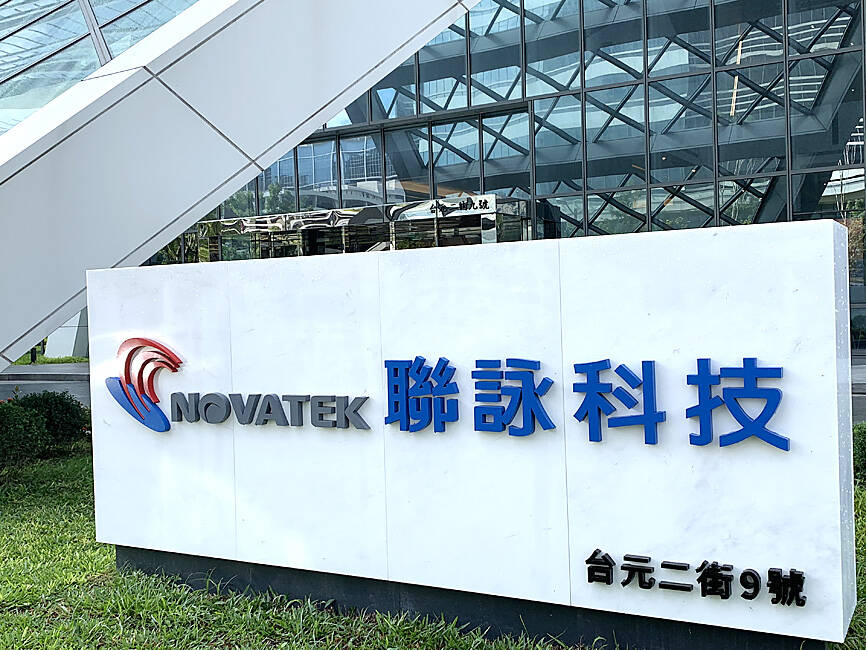Display driver IC supplier Novatek Microelectronics Corp (聯詠) yesterday said revenue this quarter would drop more than 10 percent sequentially, which it attributed to weak demand for consumer electronics, but should return to growth next year driven by new product launches.
The company expects its first organic light-emitting diodes (OLED) touch with display driver integration (TDDI) chips to enter volume production in the second quarter of next year, Novatek president Steve Wang (王守仁) told an online investors’ conference.
“We are cooperating with customers, including flat-panel makers and mobile phone vendors, to develop this product. The development is on track,” Wang said.

Photo: Grace Hung, Taipei Times
The company is likely to supply its new OLED TDDI chips to Apple Inc’s new iPhone series next year, local media reports said.
“With several new products scheduled to be introduced next year, Novatek believes that revenue should grow as a result,” Wang said.
Artificial intelligence-enabled smartphones, laptops and PCs are expected to stimulate replacement demand next year, but the outlook for consumer electronics remains uncertain, he said.
Novatek’s reported revenue in the first 10 months of this year shrank 7.28 percent annually to NT$86.05 billion (US$2.67 billion).
The company forecast that revenue this quarter would reach between NT$24 billion and NT$25 billion, compared with NT$27.87 billion last quarter, dragged by a decline in the company’s television chip business, Wang said.
Small and medium display driver ICs were the biggest revenue contributor last quarter, making up 42 percent. Large display driver chips came in next at 37 percent, with the remaining 21 percent coming from television chips.
“The recovery momentum in the overall consumer electronics segment remained weak in the fourth quarter, except for the smartphone segment,” Wang said.
“Demand for monitors and notebook computers also looks weak,” Wang added.
The company expects gross margin to drop to between 37 percent and 40 percent, compared with 39.74 percent last quarter, the lowest in three-and-a-half years, due to a less favorable product mix, rising gold prices and downward price adjustments for certain goods.
As the display driver IC industry enters its slow season this quarter, the company aims to enhance its cost control measures and upgrade product specifications to buoy gross margins, Wang said.
The company reported third-quarter net profit sank 17.4 percent year-on-year and was down 2.4 percent quarter-on-quarter to NT$5.36 billion. Earnings per share dropped to NT$8.64, compared with NT$10.46 a year ago and NT$8.86 the previous quarter.

TECH BOOST: New TSMC wafer fabs in Arizona are to dramatically improve US advanced chip production, a report by market research firm TrendForce said With Taiwan Semiconductor Manufacturing Co (TSMC, 台積電) pouring large funds into Arizona, the US is expected to see an improvement in its status to become the second-largest maker of advanced semiconductors in 2027, Taipei-based market researcher TrendForce Corp (集邦科技) said in a report last week. TrendForce estimates the US would account for a 21 percent share in the global advanced integrated circuit (IC) production market by 2027, sharply up from the current 9 percent, as TSMC is investing US$65 billion to build three wafer fabs in Arizona, the report said. TrendForce defined the advanced chipmaking processes as the 7-nanometer process or more

China’s Huawei Technologies Co (華為) plans to start mass-producing its most advanced artificial intelligence (AI) chip in the first quarter of next year, even as it struggles to make enough chips due to US restrictions, two people familiar with the matter said. The telecoms conglomerate has sent samples of the Ascend 910C — its newest chip, meant to rival those made by US chipmaker Nvidia Corp — to some technology firms and started taking orders, the sources told Reuters. The 910C is being made by top Chinese contract chipmaker Semiconductor Manufacturing International Corp (SMIC, 中芯) on its N+2 process, but a lack

NVIDIA PLATFORM: Hon Hai’s Mexican facility is to begin production early next year and a Taiwan site is to enter production next month, Nvidia wrote on its blog Hon Hai Precision Industry Co (鴻海精密), the world’s biggest electronics manufacturer, yesterday said it is expanding production capacity of artificial intelligence (AI) servers based on Nvidia Corp’s Blackwell chips in Taiwan, the US and Mexico to cope with rising demand. Hon Hai’s new AI-enabled factories are to use Nvidia’s Omnivores platform to create 3D digital twins to plan and simulate automated production lines at a factory in Hsinchu, the company said in a statement. Nvidia’s Omnivores platform is for developing industrial AI simulation applications and helps bring facilities online faster. Hon Hai’s Mexican facility is to begin production early next year and the

Who would not want a social media audience that grows without new content? During the three years she paused production of her short do-it-yourself (DIY) farmer’s lifestyle videos, Chinese vlogger Li Ziqi (李子柒), 34, has seen her YouTube subscribers increase to 20.2 million from about 14 million. While YouTube is banned in China, her fan base there — although not the size of YouTube’s MrBeast, who has 330 million subscribers — is close to 100 million across the country’s social media platforms Douyin (抖音), Sina Weibo (新浪微博) and Xiaohongshu (小紅書). When Li finally released new videos last week — ending what has